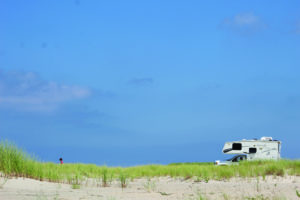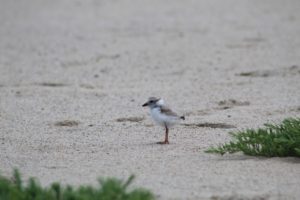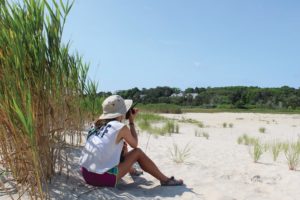ORLEANS — From the sandy bank of Pochet Creek emerge two small piping plover chicks. Their fuzzy plumage serves as camouflage against the sand, making it nearly impossible to spot them as they dart across the wash. Their orange legs move in a blur, then pause in a tuft of beach grass. They are 18 days old and have yet to fledge. They are foraging, unaware of the parade of vehicles just beyond the phragmites that conceal this stretch of sand.
Orleans Dept. of Natural Resources
BUGGIES & BIRDS
On ‘the Outer,’ Piping Plover Protection Is Working
From Nauset Beach to Race Point, shorebird programs balance over-sand vehicle access
ORLEANS — From the sandy bank of Pochet Creek emerge two small piping plover chicks. Their fuzzy plumage serves as camouflage against the sand, making it nearly impossible to spot them as they dart across the wash. Their orange legs move in a blur, then pause in a tuft of beach grass. They are 18 days old and have yet to fledge. They are foraging, unaware of the parade of vehicles just beyond the phragmites that conceal this stretch of sand.
The procession of cars snakes along slowly. Fifteen feet ahead of each vehicle walks a passenger, leading a car through the “self-escort” zone of Nauset Beach South’s over-sand vehicle (OSV) trail.

Though passengers are told to scan the tire tracks for piping plovers as they walk, most have never seen the unfledged chicks that forage in the creek beside them.
The OSV trail opened with limited access on July 27 this year. Due to the presence of unfledged chicks, some restrictions are dictated by the state’s Habitat Conservation Plan (HCP). Enforced by the Orleans Dept. of Natural Resources, the plan allows recreational OSV access on Nauset Beach while protecting the piping plovers in their habitat.
Under both the U.S. and Mass. endangered species acts, the piping plover is listed as threatened. The global population of piping plovers is fewer than 10,000; in Massachusetts, only 700 breeding pairs remain. The HCP, adopted in 2016, seems to be helping. In 1986, there were only 140 pairs left in the state.
Prepared by the Mass. Div. of Fisheries and Wildlife (DMF), the HCP aims to balance conservation and beach access. As part of the plan, the DMF and U.S. Fish & Wildlife Service (USFWS) issued a certificate of inclusion that allows Orleans to apply the HCP to Nauset Beach.
With that certificate, the plan permits the passage of up to 180 OSVs per day through the Pochet wash area — as long as no more than eight unfledged piping plover chicks and four adults are present.

Before the implementation of the plan, OSVs were simply prohibited whenever unfledged chicks were present.
“I think the key word here is balance,” says Keegan Burke, natural resource officer and shorebird specialist for the town. The balance is between monitoring and protecting the shorebirds and allowing people access to the outer beach.
The OSV community, eager each summer to enjoy “the Outer,” took advantage of the South Side’s opening. Capacity for OSVs was reached both days of the first weekend, according to Burke.
“The word was out,” says Burke. “Overall, it was a success.”
Access to the OSV South trail is currently limited to three two-hour windows, and the self-escorting procedure is in place for a designated stretch of trail that precedes Riley Wash and Trail 1 access.

Ten natural resource staff members, along with Burke and two assistants, enforce the HCP and ensure that the unfledged piping plover chicks remain protected while OSV recreation resumes.
Behind the scenes, at least one member of the HCP staff is constantly monitoring the brood of unfledged chicks throughout the day. The piping plover is a precocial species, meaning that it can feed itself within a few hours of leaving the nest. Highly mobile, it forages on both sides of the OSV trail, often crossing the corridor in search of food.
It is the job of the HCP staff to ensure that whenever a crossing occurs, the plover chick is safe from vehicles. Specific access windows help limit the threat, but the chicks are fast and unpredictable, so the monitoring is nonstop.
“The fencing, keeping track of the plovers, and having regulations on dogs and vehicles,” says Burke. “There’s no question it works. The plovers are doing well.”
This year, Burke and natural resources staff recorded more than 40 breeding pairs of piping plovers on Nauset Beach. “Numbers are slowly increasing,” Burke says. Six to eight years ago, he says, there were only 20.
Piping plover monitoring and preparation begins in early March when the staff starts to install fencing and signage. The plovers arrive in April and begin to form nests and lay eggs in May.
At that point, “Our day-to-day routine is walking the beach and monitoring pairs, identifying where their territories are, and staying on top of their egg-laying cycle,” says Burke. “We keep track of their incubation period, so we know exactly when they start to lay and exactly when they’ll hatch.”
As chicks hatch in June, Burke and his team must count chicks and keep close tabs on every brood. “Then starts that countdown to when we can start talking about opening sections of the beach up for OSV passage,” says Burke.
“It sounds simple, in a sense, but when you have seven or eight miles of beach and over 40 pairs of plovers, it’s a lot,” says Burke.
National Seashore Rules
The National Seashore has its own rules for over-sand vehicles — the Park calls them off-road vehicles or ORVs.
In the Seashore, access is possible along 10.5 miles of shoreline, from Head of the Meadow Beach in Truro to Race Point Beach in Provincetown. An extensive shorebird monitoring program is in place for this section of the Cape, but there is no HCP.
On Aug. 6, the Seashore opened a 0.8-mile section of the ORV corridor, but the rest of the corridor has remained closed since the beginning of the hatching season.

“The biggest distinction between Nauset Beach and the National Seashore is that we are operating under a federal negotiated rule for our ORV corridor,” says Seashore Supt. Brian Carlstrom. The rule dates to 1998 and involved 22 agencies, organizations, and interest groups, according to the 2020 ORV Annual Report.
In the Park, sales are limited to 400 active seven-day permits and 3,000 annual permits. The rule sets boundaries for ORV corridors and leaves open the possibility that some or all of the corridors will be closed for periods.
While the Seashore has considered implementing an HCP to allow earlier ORV access to beaches, Carlstrom says such a program would not be realistic.
The issue is staffing. “Operationally, that type of a program is so labor-intensive that it’s really not feasible,” he says.
In 2018, however, the Seashore completed a shorebird management plan that gave the Park more discretion. In June, for example, one access point was kept open even though a plover nest was located nearby.
A Seashore team keeps track of plover activity. “We have our biological technicians and interns out there on a daily basis covering different areas of the Seashore,” says Carlstrom. They know where plover nests are, set up fencing, and track predation events.
Sometimes, says Carlstrom, the bird conditions might be right, but slope erosion and changing terrain makes limiting ORV access necessary.
“ORVing is a part of the Outer Cape experience that predates the Seashore,” says Carlstrom. As with the Orleans plan, balance is the goal. “We do everything we can to provide as much access as possible, while trying to make sure that birds are as protected as they can be,” he says.
Over time, the Seashore has seen a promising increase in breeding pairs of plovers, just as the Orleans Dept. of Natural Resources has. In 2020, there were 92 breeding pairs in the Seashore and 171 fledged chicks recorded.
“Without the level of protection and work that we do, we would not be seeing the improving numbers of plovers that we have had,” Carlstrom says. “This work is imperative.”
